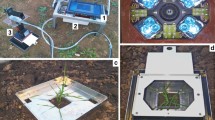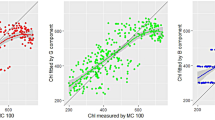Abstract
Automatic identification of crop and weed species is required for many precision farming practices. The use of chlorophyll fluorescence fingerprinting for identification of maize and barley among six weed species was tested. The plants were grown in outdoor pots and the fluorescence measurements were done in variable natural conditions. The measurement protocol consisted of 1 s of shading followed by two short pulses of strong light (photosynthetic photon flux density 1700 μmol m−2 s−1) with 0.2 s of darkness in between. Both illumination pulses caused the fluorescence yield to increase by 30–60% and to display a rapid fluorescence transient resembling transients obtained after long dark incubation. A neural network classifier, working on 17 features extracted from each fluorescence induction curve, correctly classified 86.7–96.1% of the curves as crop (maize or barley) or weed. Classification of individual species yielded a 50.2–80.8% rate of correct classifications. The best results were obtained if the training and test sets were measured on the same day, but good results were also obtained when the training and test sets were measured on different dates, and even if fluorescence induction curves measured from both leaf sides were mixed. The results indicate that fluorescence fingerprinting has potential for rapid field separation of crop and weed species.







Similar content being viewed by others
References
R Development Core Team. (2008). R: A language and environment for statistical computing. Vienna: R Foundation for Statistical Computing. http://www.R-project.org. Accessed October 9, 2010.
Aitkenhead, M. J., Dalgetty, I. A., Mullins, C. E., McDonald, A. J. S., & Strachan, N. J. C. (2003). Weed and crop discrimination using image analysis and artificial intelligence methods. Computers and Electronics in Agriculture, 39, 157–171.
Baker, N. R., & Rosenqvist, E. (2004). Applications of chlorophyll fluorescence can improve crop production strategies: An examination of future possibilities. Journal of Experimental Botany, 55, 1607–1621.
Basheer, I. A., & Hajmeer, M. (2000). Artificial neural networks: fundamentals, computing, design, and application. Journal of Microbiological Methods, 43, 3–31.
Berge, T. W., Aastweit, A. H., & Fykse, H. (2008). Evaluation of an algorithm for automatic detection of broad-leaved weeds in spring cereals. Precision Agriculture, 8, 391–405.
Berger, S., Papadopoulos, M., Schreiber, U., Kaiser, W., & Roitsch, T. (2004). Complex regulation of gene expression, photosynthesis and sugar levels by pathogen infection in tomato. Physiologia Plantarum, 122, 419–428.
Bossu, J., Gée, Ch., Jones, J., & Truchetet, F. (2009). Wavelet transform to discriminate between crop and weed in perspective agronomic images. Computers and Electronics in Agriculture, 65, 133–143.
Christensen, S., Søgaard, H. T., Kudsk, P., Nørremark, M., Lund, I., Nadimi, E. S., et al. (2009). Site-specific weed control technologies. Weed Research, 49, 233–241.
Codrea, M. C., Aittokallio, T., Keränen, M., Tyystjärvi, E., & Nevalainen, O. S. (2003). Feature learning with a genetic algorithm for fluorescence fingerprinting of plant species. Pattern Recognition Letters, 24, 2663–2673.
Codrea, M. C., Aittokallio, T., Keränen, M., Tyystjärvi, E., & Nevalainen, O. S. (2004). Genetic algorithms-based feature learning method; an application to fluorescence fingerprinting. Lecture Notes in Computer Science, 2936, 371–383.
Gebhardt, S., & Kühlbauch, W. (2007). A new algorithm for automatic Rumex obtusifolius detection in digital images using colour and texture features and the influence of image resolution. Precision Agriculture, 8, 1–13.
Gerhards, R., & Christensen, S. (2006). Site-specific weed management. In A. Srinivasan (Ed.), Handbook of precision agriculture. Principles and applications (pp. 185–205). New York: The Haworth Press Inc.
Hague, T., Tillett, N. D., & Wheeler, H. (2006). Automated crop and weed monitoring in widely spaced cereals. Precision Agriculture, 7, 21–32.
Hemming, J., & Rath, T. (2006). Computer vision based weed identification under field conditions using controlled lightning. Journal of agricultural Engineering Research, 78, 233–243.
Ishak, A. J., Hussain, A., & Mustafa, M. M. (2009). Weed image classification using Gabor wavelet and gradient field distribution. Computers and Electronics in Agriculture, 66, 53–61.
Keränen, M., Aro, E. M., Nevalainen, O., & Tyystjärvi, E. (2009). Toxic and non-toxic Nodularia strains can be distinguished from each other and from eukaryotic algae with chlorophyll fluorescence fingerprinting. Harmful Algae, 8, 817–822.
Keränen, M., Aro, E.-M., Tyystjärvi, E., & Nevalainen, O. (2003). Automatic plant identification with chlorophyll fluorescence fingerprinting. Precision Agriculture, 4, 53–67.
Loghavi, M., & Mackvandi, B. B. (2008). Development of a target oriented weed control system. Computers and Electronics in Agriculture, 63, 112–118.
Longchamps, L., Panneton, B., Samson, G., Leroux, G. D., & Thériault, R. (2010). Discrimination of corn, grasses and dicot weeds by their UV-induced fluorescence spectral signature. Precision Agriculture, 11, 181–197.
Maxwell, K., & Johnson, G. N. (2000). Chlorophyll fluorescence—a practical guide. Journal of Experimental Botany, 51, 659–668.
Meier, U. (Ed.). (2001). Growth stages of mono- and dicotyledonous plants. BBCH monograph. Blackwell, Berlin-Wien: Federal Biologische Research Centre for Agriculture and Forestry.
Meyer, G. E., Mehta, T., Kocher, M. F., Mortensen, D. A., & Samal, A. (1998). Textural imaging and discriminant analysis for distinguishing weeds for spot spraying. Transactions of the ASAE, 41, 1189–1197.
Meyer, G. E., & Neto, J. C. (2008). Verification of color vegetation indices for automated crop imaging applications. Computers and Electronics in Agriculture, 63, 282–293.
Mishra, A., Matouš, K., Mishra, K. B., & Nedbal, L. (2009). Towards discrimination of plant species by machine vision: Advanced statistical analysis of chlorophyll fluorescence transients. Journal of Fluorescence, 19, 905–913.
Moshou, D., Vrindts, E., De Ketelaere, B., De Baerdemaeker, J., & Ramon, H. (2001). A neural network based plant classifier. Computers and Electronics in Agriculture, 31, 5–16.
Nedbal, L., Soukupová, J., Kaftan, D., Whitmarsh, J., & Trílek, M. (2000). Kinetic imaging of chlorophyll fluorescence using modulated light. Photosynthesis Research, 66, 3–12.
Neubauer, C., & Schreiber, U. (1987). The polyphasic rise of chlorophyll fluorescence upon onset of strong continuous illumination. 1. Saturation characteristics and partial control by the Photosystem-II acceptor side. Zeitschrift für Naturforschung C—A Journal of Biosciences, 42, 1246–1254.
Nørremark, M., Griepentrog, H. W., Nielsen, J., & Søgaard, H. T. (2008). The development and assessment of the accuracy of an autonomous GPS-based system for intra-row mechanical weed control in row crops. Biosystems Engineering, 101, 396–410.
Nørremark, M., Søgaard, H. T., Griepentrog, H. W., & Nielsen, H. (2007). Instrumentation and method for high accuracy geo-referencing of sugar beet plants. Computers and Electronics in Agriculture, 56, 130–146.
Ounis, A., Evain, J., Flexas, J., Tosti, S., & Moya, I. (2001). Adaptation of a PAM-fluorometer for remote sensing of chlorophyll fluorescence. Photosynthesis Research, 68, 113–120.
Persson, M., & Åstrand, B. (2008). Classification of crops and weeds extracted by active shape models. Biosystems Engineering, 100, 484–497.
Rasmussen, J., Nørremark, M., & Bibby, B. M. (2007). Assessment of leaf cover and crop soil cover in weed harrowing research using digital images. Weed Research, 47, 299–310.
Ripley, R. B. (1996). Pattern recognition and neural networks. Cambridge: Cambridge University Press.
Slaughter, D. C., Giles, D. K., & Downey, D. (2008). Autonomous robotic weed control systems: A review. Computers and Electronics in Agriculture, 61, 63–78.
Søgaard, H. T., & Lund, I. (2007). Application accuracy of a machine vision-controlled robotic micro-dosing system. Biosystems Engineering, 96, 315–322.
Srinivasan, A. (Ed.). (2006). Handbook of precision agriculture. Principles and applications. New York: The Haworth Press Inc.
Strasser, R. J., Srivastava, A., & Govindjee, (1995). Polyphasic chlorophyll a fluorescence transient in plants and cyanobacteria. Photochemistry and Photobiology, 61, 32–42.
Strasser, R. J., Tsimilli-Michael, M., & Srivastava, A. (2004). Analysis of the chlorophyll a fluorescence transient. In G. C. Papageorgiou & Govindjee (Eds.), Chlorophyll fluorescence: A signature of photosynthesis (pp. 363–388). The Netherlands: Springer.
Sui, R., Thomasson, J. A., Hanks, J., & Wooten, J. (2008). Ground-based sensing system for weed mapping in cotton. Computers and Electronics in Agriculture, 60, 31–38.
Tyystjärvi, E., & Karunen, J. (1990). A microcomputer program and fast analog to digital converter card for the analysis of fluorescence induction transients. Photosynthesis Research, 26, 127–132.
Tyystjärvi, E., Koski, A., Keränen, M., & Nevalainen, O. (1999). The Kautsky curve is a built-in barcode. Biophysical Journal, 77, 1159–1167.
Van Kooten, O., & Snel, J. F. H. (1990). The use of chlorophyll fluorescence terminology in plant stress physiology. Photosynthesis Research, 25, 147–150.
Vass, I., Kirilovsky, D., & Etienne, A. L. (1999). UV-B radiation-induced donor- and acceptor-side modifications of photosystem II in the cyanobacterium Synechocystis sp PCC 6803. Biochemistry, 38, 12786–12794.
Venables, W. N., & Ripley, B. D. (2002). Modern applied statistics with S (4th ed.). New York: Springer.
Vioix, J.-B., Douzals, J.-P., Truchetet, F., Assémat, L., & Guillemin, J.-P. (2002). Spatial and spectral methods for weed detection and localization. Journal on Applied Signal Processing, 7, 679–685.
Wang, N., Zhang, N., Wei, J., Stoll, Q., & Peterson, D. E. (2007). A real-time, embedded, weed-detection system for use in wheat fields. Biosystems Engineering, 98, 276–285.
Wiles, L. J. (2009). Beyond patch spraying: site-specific weed management with several herbicides. Precision Agriculture, 10, 277–290.
Zhang, Y., Staab, E. S., Slaughter, D. C., Giles, D. K., & Downey, D. (2009). Precision automated weed control using hyperspectral vision identification and heated oil. ASABE Paper No. 096365. St. Joseph, MI: ASABE
Acknowledgments
The authors thank Senior Scientist Solvejg K. Mathiassen, University of Aarhus, Faculty of Agricultural Sciences, Department of Integrated Pest Management, and green house manager Willy Rasmussen, for providing plants. This work was financially supported by the Danish Food Industry Agency, Ministry of Food, Agriculture and Fisheries, and Academy of Finland.
Author information
Authors and Affiliations
Corresponding author
Rights and permissions
About this article
Cite this article
Tyystjärvi, E., Nørremark, M., Mattila, H. et al. Automatic identification of crop and weed species with chlorophyll fluorescence induction curves. Precision Agric 12, 546–563 (2011). https://doi.org/10.1007/s11119-010-9201-6
Published:
Issue Date:
DOI: https://doi.org/10.1007/s11119-010-9201-6




